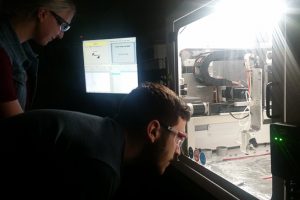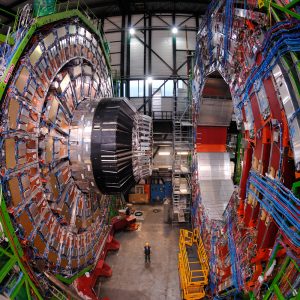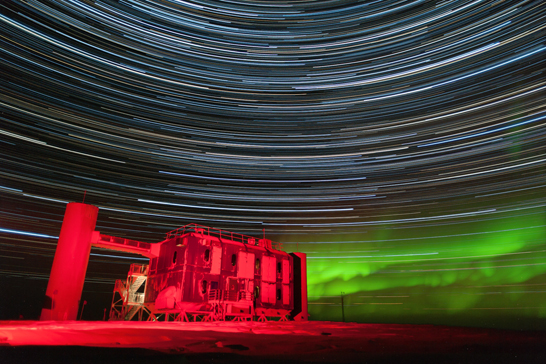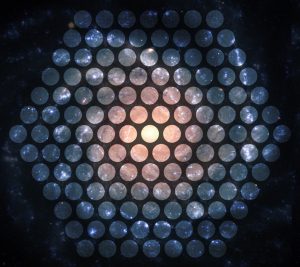The Department of Physics & Astronomy at The University of Alabama has a diverse research program in the following major areas:
- Condensed Matter Physics Experimental
- Condensed Matter Physics Theoretical
- Precision Timing and Quantum Metrology
- Particle Physics Experimental
- Particle Physics Theoretical
- Particle Astrophysics
- Astronomy and Astrophysics
Experimental Condensed Matter Physics
Experimental Condensed Matter Physics Group

Much of the research in condensed-matter physics at The University of Alabama is conducted as an interdisciplinary program that involves faculty from several departments. The work ranges from quite applied work (e.g., Dr. Adam Hauser works on the fabrication and study of new electronic and magnetic materials) to very fundamental studies (e.g., Dr. Tim Mewes‘s work on the interaction between magnetization and phonons and other damping mechanisms in metals).
Experimental work is facilitated by two clean rooms. Several sputtering systems are available for sample synthesis. Characterization equipment includes alternating-gradient and superconducting vibrating-sample magnetometers, as well as scanning and transmission electron microscopes, scanning atomic force and tunneling microscopes, and Auger and x-ray photoelectron spectroscopy. Dr. Patrick LeClair specializes in low temperature measurements and superconducting tunnel junctions. Dr. Paulo Araujo focuses on Near-Field, Raman and Photoluminescence spectroscopy of 1D-materials (single-, double- and triple-wall carbon nanotubes) and 2D-materials (such as graphene and transition metal dichalcogenides). He has also been working on the growth of graphene using the chemical vapor deposition technique. Dr. Adam Hauser works on the fabrication and study of new electronic and magnetic materials. Dr. Jamileh Beik Mohammadi works in the area of magnetism and spintronics. She utilizes experimental methods and theoretical modeling to design and characterize magnetic thin films and multilayers. Dr. Marzieh Kavand works on spin interactions and spin dynamics on small ensemble of molecules, thin film materials and quantum devices for applications in quantum sensing and quantum processing to study novel quantum phenomena in quantum materials and devices. Dr. Yi Lin focuses on studying the behavior of electrons in the equilibrium or excited phases of materials. He directly visualizes the electronic band structure of materials using angle-resolved photoemission spectroscopy (ARPES).
Many students who have received graduate degrees are now employed in the information storage industry.
Theoretical Condensed Matter Physics
Theoretical Condensed Matter Physics Groups
There is also a substantial theoretical component to the research conducted in condensed matter physics. Dr. Wang-Kong Tse works on the effects of strong magnetic or optical fields, topological properties, as well as many-body interactions in low-dimensional electron systems; his research is often motivated by an attempt to explain interesting experimental observations or to bridge between different topics so as to produce new physical insights or predictions of new phenomena. Dr. Georg Schwiete studies transport and non-equilibrium phenomena in disordered many-body systems and quantum materials, including aspects of spintronics.
Precision Timing and Quantum Metrology
Precision Timing and Quantum Metrology Group
Precision Timing and Quantum Metrology involves basic and applied research on the positioning, navigation, timing, and frequency aspects. Innumerable applications of this science and technology are a silent infrastructure that is the backbone of modern-day living – GPS/GNSS, telecommunication synchronization, power grid synchronization, precise navigation, definition & maintenance of the Universal Coordinated Time (UTC), and various strategic applications – only to name a few. Our work covers the basic research on spectroscopy of atomic and optical clocks and their applications – ranging from timescales, time- and frequency- synchronization techniques, to precision quantum sensors (atomic clocks and magnetometers) and basic metrological studies. Inception of the group at the University of Alabama occurred in January 2022.
Dr. Thejesh Bandi is leading our Precision Timing and Quantum Metrology research along with Dr. Adam Hauser and Dr. Patrick LeClair. The group has various collaborations within UA: with faculty in the department of Engineering (UA), department of mathematics, and the UA Transportation Institute. We have an Educational Partnership Agreement (EPA) with the United States Naval Observatory (USNO). A recent funding from NSF-NRT under the ACCEPT (Alabama Collaborative for Contemporary Education in Precision Timing) program – where graduate level students are being trained in Precision Timing related research and leadership skills – has boosted our activities further.
Experimental Particle Physics
Experimental Particle Physics Groups
The experimental particle physics faculty are members of international collaborations carrying out searches for neutrino oscillations and neutrino-less double beta decay (Piepke, Stancu, Ostrovskiy), direct detection of dark matter particles (Piepke, Stancu, Ostrovskiy, Wang), as well as signs of new physics beyond the Standard Model of elementary particle physics (Rumerio, Gleyzer, Usai).
Major Collaborations
- nEXO/EXO – Enriched Xenon Observatory (NM)
- KamLAND (Japan)
- MiniBooNE (Fermilab)
- Dark Matter search
- Collider Physics
- CMS (Compact Muon Solenoid) experiment at CERN’s Large Hadron Collider (Switzerland)
- MoEDAL (Monopole and Exotics Detector at the LHC (MoEDAL) experiment at CERN’s Large Hadron Collider (Switzerland)

The aim of the neutrino experiments is to shed further light on the questions of neutrino mass, neutrino flavor mixing, and the nature (Dirac versus Majorana) of the neutrino. A major part of the group’s work in performing detector simulation studies (designing and building detector subsystems and carrying out data analysis for physics) is done on campus, making extensive use of local resources. These resources include several thousand-square feet of well-equipped laboratory space, a high-sensitivity radioassay laboratory, professionally staffed machine and electronics shops, and a cluster of computer workstations with high-speed network (Internet2) connections.
The group is also involved in the LZ experiment, which seeks to directly detect dark matter particles.
Dr. Paolo Rumerio, Dr. Sergei Gleyzer, and Dr. Emanuele Usai collaborate on the Compact Muon Solenoid (CMS) experiment at the Large Hadron Collider (LHC) in CERN, the European particle physics laboratory in Switzerland. The LHC collides protons at the highest energies ever achieved in the laboratory, and these high-energy collisions were used to discover the elusive Higgs boson in 2012. The CMS experiment continues to take data to study the Higgs boson, to perform precise measurements of the Standard Model of particle physics, and to search for physics beyond the Standard Model.
Particle Theory
Supersymmetry is a unifying principle which helps overcome the divergence problem and the “naturalness” problem of the Standard Model. All consistent string theories are supersymmetric. Therefore the study of supersymmetric spacetimes is worthwhile because of the intrinsic interest of such spacetimes and because of their importance to other theoretical investigations. There are relatively few spacetimes which possess at least some supersymmetries.
Dr. Allen Stern‘s current research interests include solitons, topological field theories, duality, quantum groups, and applications of noncommutative geometry.
Dr. Matthias Kaminski connects fundamental theoretical principles with feasible experiments, using both analytical and numerical methods. In particular, Dr. Kaminski considers principles learned from the mathematical framework of string theory. Then he applies these fundamental principles to strongly coupled quantum systems, which are far from being in equilibrium. Example systems for such far-from-equilibrium physics of strongly coupled systems are heavy ion collisions, our universe right after the Big Bang, neutron stars, ultracold atoms, and particular phases of condensed matter.
Dr. Nobuchika Okada, a theorist, is investigating signals for new physics at the Large Hadron Collider and in astrophysical observations.
Particle Astrophysics
- IceCube Neutrino Observatory (Antarctica)
- VERITAS Gamma Ray Observatory (Arizona)

Dr. Dawn Williams is involved in various aspects of calibration of large volume neutrino telescopes. She is a member of the IceCube Neutrino Observatory, IceCube-Gen2, and the Radio Neutrino Observatory — Greenland (RNO-G) collaborations. Dr. Williams is the co-convenor of the IceCube Neutrino Observatory calibration working group, the Level 2 Lead for Calibration and Characterization for the IceCube Upgrade project, and the Level 2 Lead for Detector Calibration and Commissioning for IceCube-Gen2.
Dr. Marcos Santander is interested in high-energy neutrino astrophysics and multi-messenger searches for neutrino sources using gamma-ray and X-ray telescopes. He is involved with IceCube and the Very Energetic Radiation Imaging Telescope Array System (VERITAS), a ground-based gamma-ray instrument operating at the Fred Lawrence Whipple Observatory (FLWO) in southern Arizona, USA.
Adjunct Prof. Biermann is active in high-energy astrophysics, particularly in theoretical studies of cosmic rays and active galactic nuclei.
Astronomy & Astrophysics

The astronomy group consists of seven faculty whose research focuses on extragalactic astronomy, with approximately equal emphasis on theory and observation. Active research areas include the following:
- Galaxy morphology, disks, and resonance phenomena, from both observational and dynamical points of view (Dr. Preethi Nair, Dr. Jeremy Bailin). This involves observations of various tracers of star-formation history and Doppler mapping to recover the locations of resonant points in spiral galaxies, to allow a detailed comparison with theory to refine our understanding of the internal working of galaxies.
- Galaxy interactions, AGN, and evolution (Dr. Preethi Nair): comparison of galaxies in various redshift ranges to build a consistent picture of how galaxy populations have changed with cosmic time.
- Galaxy formation (Dr. Jeremy Bailin): computer simulations of the formation of galaxies out of the nearly-smooth early Universe.
- Galaxy halos (Dr. Jeremy Bailin): observational and theoretical studies of the stars, dark matter, dwarf galaxies, and globular star clusters in the outskirts of galaxies.
- Observational and theoretical study of hot gas in galaxies and clusters of galaxies (Dr. Jimmy Irwin, Dr. Ray White), using the observed chemistry and energetics to constrain how galaxies evolve.
- Observational study of neutron stars and black holes accreting matter from neighboring stars in binary stellar systems (Dr. Jimmy Irwin).
- Theoretical study of white dwarfs accreting matter from neighboring stars, leading to stellar explosions (Dr. Dean Townsley).
- Theoretical study of planet formation (Dr. Chao-Chin Yang), and its implications for exoplanetary sciences and our Solar System.
Major Collaborations and Resources
- SARA Observatory consortium
(telescopes at Kitt Peak, AZ & Cerro Tololo, Chile) - Galaxy Zoo
- Sloan Digital Sky Survey IV
The astronomy group uses a network of Linux and Apple computers, including a high performance Linux cluster, along with astronomical software packages such as IRAF, IDL & Ciao. The high-speed computing facilities of the Alabama Research and Education Network in Huntsville are available. The University is part of the Southeastern Association for Research in Astronomy (SARA), which operates optical telescopes in Arizona and Chile, of which UA observers have a 10% share. Dr. Nair’s group are members of the Sloan Digital Sky Survey. Astronomy group members are regular users of NASA satellite observatories (Hubble, Chandra, XMM-Newton, GALEX, Swift, Suzaku) and ground-based telescopes worldwide. Research is supported by the NSF and NASA.